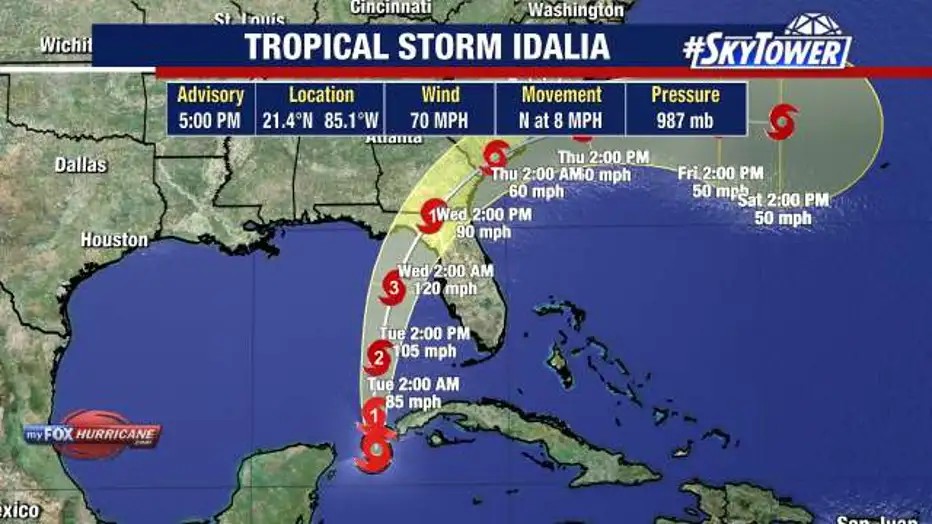GUANIMAR, Cuba, (Reuters) – Tropical Storm Idalia lashed western Cuba and was expected to strengthen into a major hurricane today as it crawled toward Florida’s Gulf Coast, whereofficials ordered evacuations and urged residents to prepare in advance of an expected Wednesday morning landfall.
Idalia was churning about 80 miles (130 km) off the western tip of Cuba as it barreled north, packing maximum sustained winds of 70 mph (112 kph), the National Hurricane Center said in its latest advisory.
The storm’s growing intensity and its current northerly track put some 14 million Floridians under hurricane and tropical storm warnings.
“Buckle up for this one,” Florida Governor Ron DeSantis said during a news conference on Monday afternoon, adding that he spoke to U.S. President Joe Biden and the director of the Federal Emergency Management Agency (FEMA), Deanne Criswell.
“Do what you got to do. You still have time today. You have time for most of tomorrow,” he added, urging Floridians to prepare for the potentially dangerous conditions.
Cubans rushed to evacuate coastal towns, batten down homes and tie down fishing boats as Idalia made landfall on the island nation shortly after 2 p.m. local time.
Chocolate brown floodwaters had swamped the small fishing village of Guanimar, just one hour south of Havana, by mid-afternoon.
Decades-old buses missing floorboards and windows carried women and children to higher ground as winds howled, rattling tin roofs and slamming fishing boats tucked in the mangroves.
“We’ve had two days of rain already,” said Yadira Alvarez, 34, as she prepared for evacuation with her five children. “We try to prepare, but no matter what we do everything will be soaked.”
Stormwater had already swelled to near knee-height inside her home, she said.
Farther to the west, more intense winds closer to the storm center pounded the tobacco-rich province of Pinar del Rio, home to the raw material for some of the world’s finest Cuban cigars.
Authorities had evacuated tens of thousands of people from that province as well as the neighboring farm province of Artemisa. Squalls of heavy rain began to douse the Cuban capital of Havana by mid-afternoon with only light winds reported.
Idalia was expected to reach Category 3 strength on the Saffir-Simpson hurricane wind scale by the time it makes landfall in northern Florida’s Big Bend area, where the state’s Gulf Coast panhandle transitions into the state’s peninsula region, the hurricane center forecast.
Shannon Hartsfield, who runs a fishing boat in Apalachicola Bay in Franklin County on the state’s panhandle, heeded the warnings, even though he lives west of where landfall was expected.
Hartsfield and many of his fellow anglers have pulled up almost all of their boats from the bay and moved them to high ground, he said. Other fishermen who ran out of time and left their crab traps behind must now wait until after the storm to assess the damage.
“It could jog a little west and come straight at us,” Hartsfield said. “Hopefully we won’t catch the worst of it.”
Some 350 miles to the south, Manatee County was one of a handful of jurisdictions to issue mandatory evacuation orders on Monday, telling residents to seek higher ground or head out of the storm’s expected track.
By Tuesday, Florida’s Gulf Coast, southeastern Georgia and eastern portions of North and South Carolina were likely to face torrential rains of 4 to 8 inches (10 to 20 cm) that could unleash scattered flooding. Along with the heavy rain, winds of more than 110 mph (177 kph) could result in life-threatening storm surge, pushing walls of seawater inland from the shoreline, the hurricane center warned.
Ahead of the storm, school districts across the region announced they would cancel classes starting on Monday afternoon. Tampa International Airport planned to suspend commercial operations beginning at 12:01 a.m. Tuesday.
Like many beachfront communities along the coast, the city of Bradenton opened sandbag stations on Monday and urged its 55,000 residents to stay vigilant.
“Let’s be prepared – secure items that could become airborne, gas up your car, have cash and bottled water on hand,” officials said in a post on the social media platform X.
DeSantis issued a state of emergency for 46 Florida counties covering most of the northern part of the state. Some 5,500 members of the National Guard were mobilized, with 2,400 high-water vehicles and a dozen aircraft deployed for rescue and recovery efforts.
Along with thousands of electric workers staged to help restore power quickly after the storm passes, the state has about 3 million gallons of drinking water and 1.5 million meals ready to hand out to people in need after the storm, DeSantis said.
Utility firm Duke Energy DUK.N, which serves many parts of northwest Florida, said it was preparing crews and equipment to respond to the storm if customers lose power.
To the east of Idalia, Hurricane Franklin, the first major hurricane of the season, meandered in the Atlantic, where it was forecast to turn to the northeast over the next two days. The Category 3 hurricane threatened to bring heavy swells to Bermuda and the U.S. East Coast throughout the week.






